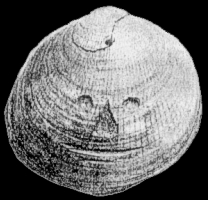Cross-posted at God Is For Suckers!
If you're anything like myself, you probably like to check out books prior to purchase. Money's money, right?
So I stumbled upon this little gem, and it piqued my interest. Humanity being much older than the accepted 100,000 years? Hmmm...
So, I foraged. Data mined, what have you.
In 1979, researchers at the Laetoli, Tanzania, site in East Africa discovered footprints in volcanic ash deposits over 3.6 million years old. Mary Leakey and others said the prints were indistinguishable from those of modern humans. To these scientists, this meant only that the human ancestors of 3.6 million years ago had remarkably modern feet. But according to other scientists, such as physical anthropologist R. H. Tuttle of the University of Chicago, fossil bones of the known australopithecines of 3.6 million years ago show they had feet that were distinctly apelike. Hence they were incompatible with the Laetoli prints. In an article in the March 1990 issue of Natural History, Tuttle confessed that "we are left with somewhat of a mystery." It seems permissible, therefore, to consider a possibility neither Tuttle nor Leakey mentioned--that creatures with anatomically modern human bodies to match their anatomically modern human feet existed some 3.6 million years ago in East Africa. Perhaps, as suggested in the illustration on the opposite page, they coexisted with more apelike creatures. As intriguing as this archeological possibility may be, current ideas about human evolution forbid it.
Gotta love that last bit, no? From much of my reading at Pharyngula, I gather that it's not uncommon in evolution for anomalies in the fossil record to show some startlingly modernistic characteristics in ancient lineage. These tend to come and go, however. Besides which, this has been adequately explained here. The footprints are much smaller than modern humans, and besides which, are obviously contaminated by the environment.
Knowledgeable persons will warn against positing the existence of anatomically modern humans millions of years ago on the slim basis of the Laetoli footprints. But there is further evidence. Over the past few decades, scientists in Africa have uncovered fossil bones that look remarkably human. In 1965, Bryan Patterson and W. W. Howells found a surprisingly modern humerus (upper arm bone) at Kanapoi, Kenya. Scientists judged the humerus to be over 4 million years old. Henry M. McHenry and Robert S. Corruccini of the University of California said the Kanapoi humerus was "barely distinguishable from modern Homo." Similarly, Richard Leakey said the ER 1481 femur (thighbone) from Lake Turkana, Kenya, found in 1972, was indistinguishable from that of modern humans. Scientists normally assign the ER 1481 femur, which is about 2 million years old, to prehuman Homo habilis. But since the ER 1481 femur was found by itself, one cannot rule out the possibility that the rest of the skeleton was also anatomically modern. Interestingly enough, in 1913 the German scientist Hans Reck found at Olduvai Gorge, Tanzania, a complete anatomically modern human skeleton in strata over 1 million years old, inspiring decades of controversy.
The Kanapoi humerus? See here. Oldoway Man? See here.
Here again, some will caution us not to set a few isolated and controversial examples against the overwhelming amount of noncontroversial evidence showing that anatomically modern humans evolved from more apelike creatures fairly recently--about 100,000 years ago, in Africa, and, in the view of some, in other parts of the world as well.
The current evidence points to yes, but this fellow is sideways hinting that he's found evidence that says otherwise.
But it turns out we have not exhausted our resources with the Laetoli footprints, the Kanapoi humerus, and the ER 1481 femur. Over he past eight years, Richard Thompson and I, with the assistance of our researcher Stephen Bernath, have amassed an extensive body of evidence that calls into question current theories of human evolution. Some of this evidence, like the Laetoli footprints, is fairly recent. But much of it was reported by scientists in the nineteenth and early twentieth centuries. And as you can see, our discussion of this evidence fills up quite a large book.
As we are in the 21st CE, any assumptions/theories/hypotheses made by scientists in the earlier years deserves more the critical eye: the techniques used back then were cruder, the base of knowledge much smaller than now. And interpretations vary, usually changing as the knowledge base grows and the science refines.
I'm going to skip ahead here and there: it's a lengthy intro to the book, and the reader is welcome to read the whole synopsis.
In the first chapter of Part I of Forbidden Archeology, we survey the history and current state of scientific ideas about human evolution. We also discuss some of the epistemological principles we employ in our study of this field. Principally, we are concerned with a double standard in the treatment of evidence.
We identify two main bodies of evidence. The first is a body of controversial evidence (A), which shows the existence of anatomically modern humans in the uncomfortably distant past. The second is a body of evidence (B), which can be interpreted as supporting the currently dominant views that anatomically modern humans evolved fairly recently, about 100,000 years ago in Africa, and perhaps elsewhere.
We also identify standards employed in the evaluation of paleoanthropological evidence. After detailed study, we found that if these standards are applied equally to A and B, then we must accept both A and B or reject both A and B. If we accept both A and B, then we have evidence placing anatomically modern humans millions of years ago, coexisting with more apelike hominids. If we reject both A and B, then we deprive ourselves of the evidential foundation for making any pronouncements whatsoever about human origins and antiquity.
Historically, a significant number of professional scientists once accepted the evidence in category A. But a more influential group of scientists, who applied standards of evidence more strictly to A than to B, later caused A to be rejected and B to be preserved. This differential application of standards for the acceptance and rejection of evidence constitutes a knowledge filter that obscures the real picture of human origins and antiquity.
So, the short version: "Listen to us, we have the actual evidence that humanity existed millions of years ago. We even have real scientists, influential ones, who agree with us!" Do they? Let's see.
Chapter 2 deals with anomalously old bones and shells showing cut marks and signs of intentional breakage. To this day, scientists regard such bones and shells as an important category of evidence, and many archeological sites have been established on this kind of evidence alone.
In the decades after Darwin introduced his theory, numerous scientists discovered incised and broken animal bones and shells suggesting that tool-using humans or human precursors existed in the Pliocene (2-5 million years ago), the Miocene (5-25 million years ago), and even earlier. In analyzing cut and broken bones and shells, the discoverers carefully considered and ruled out alternative explanations--such as the action of animals or geological pressure--before concluding that humans were responsible. In some cases, stone tools were found along with the cut and broken bones or shells.
A particularly striking example in this category is a shell displaying a crude yet recognizably human face carved on its outer surface.
Reported by geologist H. Stopes to the British Association for the Advancement of Science in 1881, this shell, from the Pliocene Red Crag formation in England, is over 2 million years old. According to standard views, humans capable of this level of artistry did not arrive in Europe until about 30,000 or 40,000 years ago. Furthermore, they supposedly did not arise in their African homeland until about 100,000 years ago.
(Note to the intrepid, curious reader: this particular piece of 'artwork' is what you see on the upper right hand corner of this post. It could've fallen a few feet and gotten those markings just as easily)
Concerning evidence of the kind reported by Stopes, Armand de Quatrefages wrote in his book Hommes Fossiles et Hommes Sauvages (1884): "The objections made to the existence of man in the Pliocene and Miocene seem to habitually be more related to theoretical considerations than direct observation."
1884? Are you kidding me?
The most rudimentary stone tools, the eoliths ("dawn stones") are the subject of Chapter 3. These imlements, found in unexpectedly old geological contexts, inspired protracted debate in the late nineteenth and early twentieth centuries.
For some, eoliths were not always easily recognizable as tools. Eoliths were not shaped into symmetrical implemental forms. Instead, an edge of a natural stone flake was chipped to make it suitable for a particular task, such as scraping, cutting, or chopping. Often, the working edge bore signs of use.
As to eoliths, answers.com gave me this:
Obsolete term, formerly used for a naturally shaped or fractured stone fancifully considered to be created by humans. The origin of eoliths was once the subject of long-running debate connected to recognizing and accepting the great antiquity of the human species.
In Chapter 6, we review discoveries of anomalously old skeletal remains of the anatomically modern human type. Perhaps the most interesting case is that of Castenedolo, Italy, where in the 1880s, G. Ragazzoni, a geologist, found fossil bones of several Homo sapiens sapiens individuals in layers of Pliocene sediment 3 to 4 million years old. Critics typically respond that the bones must have been placed into these Pliocene layers fairly recently by human burial. But Ragazzoni was alert to this possibility and carefully inspected the overlying layers. He found them undisturbed, with absolutely no sign of burial.
This adequately explains Castendolo Man. Colin Groves (at the Talkorigins site) does a brief review of the book here.
Are you starting to glaze over? I was. So I skipped ahead.
Just as Groves points out, these fellows (Michael A. Cremo and Richard L. Thompson) are affiliated with the Bhaktivedanta Institute - Cremo is a Vedic creationist, no less. So he (and his erstwhile buddy) rail about presupposition, all the while approaching the 'evidence' in an effort to prove their...eccentric viewpoint.
A quote from the link above:
Professor Jonathan Marks, a biological anthropologist at the University of North Carolina who reviewed Cremo's book in the American Journal of Physical Anthropology, said Cremo relies on poorly documented 19th century archaeological finds.
"What Cremo does in `Forbidden Archaeology' is he takes all this stuff that has been confined to the rubbish pile and says, `Look at all this evidence that archaeologists have ignored,"' Marks said. "It's not evidence at all. He believes humans existed in the Precambrian era, but the world was a very different place then. There was no oxygen, there was no life; without multi-cellular organisms, there wouldn't have been anything for them to eat."
Caught between two extremes: the Young Earthers and the Vedic contortionists. Hard to tell, sometimes, which ones are crazier than the others. I mean, they all go rooting in the trashbins of science and holler "Eureka!" when they find something that might vaguely support a premise treading on thin ice.
All the while, fool's gold.
Till the next post, then.














1 comment:
according to most creationists, these are modern human footprints that are dated at 3.7 million years ago, long before humans were meant to exist. Creationists emphasize the close resemblance between these and modern human footprints, but often neglect to mention their extremely small size and the fact they may also be similar to the feet of the australopithecines living at the same time. Exactly how similar they are is a matter of some debate.
Well, of course they neglect to mention facts which disproves their mythology beliefs. They are very good at dismissing evidence that contradicts their dusty old crazy book.
Post a Comment